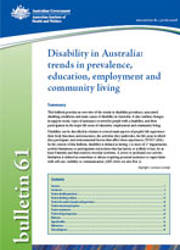Summary
This bulletin provides an overview of the trends in disability prevalence, associated disabling conditions and main causes of disability in Australia. It also outlines changes in support needs, types of assistance received by people with a disability, and their participation in the major life areas of education, employment and community living.
Disability can be described in relation to several main aspects of people’s life experience: their body functions and structures, the activities they undertake, the life areas in which they participate, and environmental factors that affect these experiences (WHO 2001). In the context of this bulletin, disability is defined as having 1 or more of 17 impairments, activity limitations or participation restrictions that has lasted, or is likely to last, for at least 6 months and that restricts everyday activities. A severe or profound core activity limitation is defined as sometimes or always requiring personal assistance or supervision with self-care, mobility or communication (ABS 2004; see also Box 2).This bulletin provides an overview of the trends in disability prevalence, associated disabling conditions and main causes of disability in Australia. It also outlines changes in support needs, types of assistance received by people with a disability, and their participation in the major life areas of education, employment and community living.
Disability can be described in relation to several main aspects of people’s life experience: their body functions and structures, the activities they undertake, the life areas in which they participate, and environmental factors that affect these experiences (WHO 2001). In the context of this bulletin, disability is defined as having 1 or more of 17 impairments, activity limitations or participation restrictions that has lasted, or is likely to last, for at least 6 months and that restricts everyday activities. A severe or profound core activity limitation is defined as sometimes or always requiring personal assistance or supervision with self-care, mobility or communication (ABS 2004; see also Box 2).
Introduction
Trends in disability prevalence
Trends in disabling conditions
Trends in the number of people needing assistance
Trends in education participation
Trends in employment
Trends in living arrangements
End matter: References; Appendix tables; Abbreviations; Acknowledgments



